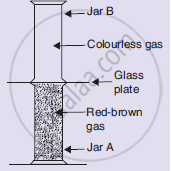Advertisements
Advertisements
Question
Which of the following diffuses fastest and which the slowest?
Solid, Liquid, Gas Give reasons for your answer.
Solution
Gases diffuse fastest and solids diffuse slowest when we compare solids, liquids and gases.
Explanation: Gases diffuse fast because the force of attraction between their particles is very low or negligible and there are vast spaces between the particles. The force of attraction between the particles of solids is very strong and there is no space between the particles due to their compact arrangement. As a result, rate of diffusion in solids is slowest.
APPEARS IN
RELATED QUESTIONS
Comment upon the following:
rigidity, compressibility, fluidity, filling a gas container, shape, kinetic energy and density.
Give a reason for the following observation.
We can get the smell of perfume sitting several metres away.
Which of the two diffuses faster : a liquid or a gas?
State whether the following statement is true or false :
Red-brown bromine vapour diffuse into air in a gas jar but the colourless air molecules do not diffuse into bromine vapour.
Fill in the following blank with suitable words :
Solid, liquid and gas are the three ........................ of matter.
Why do gases have neither a fixed shape nor a fixed volume?
What does the diffusion of gases tell us about their particles?
Look at the diagram on the right side. Jar A contains a red-brown gas whereas jar B contains a colourless gas. The two gas jars are separated by a galas plate placed between them
- What will happen when the glass plate between the two jars is pulled away?
- What name is given to the phenomenon which takes place?
- Name the brown gas which could be in jar A.
- Which is the colourless gas most likely to be present in jar B?
- Name one coloured solid and one colourless liquid which can show the same phenomenon.

The substance X normally exists in a physical state which can flow easily but does not fill its vessel completely. It also turns anhydrous copper sulphate blue. When substance X is cooled excessively, it changes into a substance Y which has a fixed shape as well as a fixed volume. If, however, the substance X is heated strongly, it changes into a substance Z which has neither a fixed shape nor a fixed volume.
- Name the substances (i) X (ii) Y and (iii) Z.
- What is the process of conversion of X into Y known as ?
- At which temperature X gets converted into Y ?
- What is the process of conversion of X into Z known as ?
- At which temperature X gets converted into Z ?
Comment upon the following:-
compressibility
